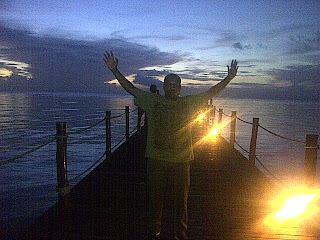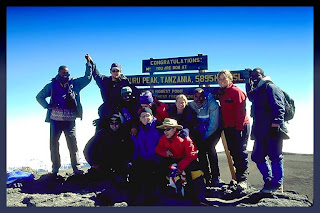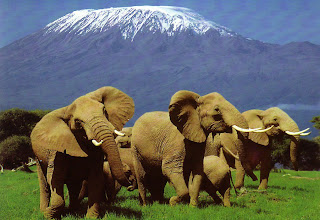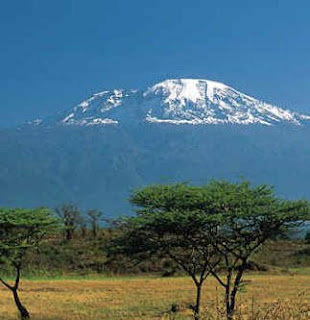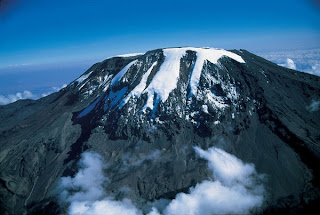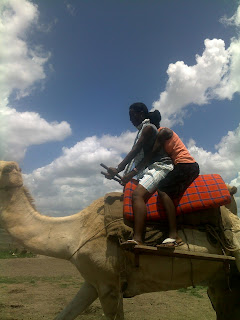STONE TOWN
Stone Town also known as Mji Mkongwe (swahili for "old town") is the old part of Zanzibar City, the main city of Zanzibar, in Tanzania, as opposed to Ng'ambo (Swahili for 'the other side'). It is located on the western coast of Unguja, the main island of the Zanzibar Archipelago. Former capital of the Zanzibar Sultanate, and flourishing centre of the spice trade as well as the slave trade in the 19th century, it retained its importance as the main city of Zanzibar during colonial rule. When Tanganyika and Zanzibar joined each other to form the United Republic of Tanzania, Zanzibar kept a semi-autonomous status, with Stone Town as its local government seat.
Stone Town is a city of prominent historical and artistic importance in East Africa. Its architecture, mostly dating back to the 19th century, reflects the diverse influences underlying the Swahili culture, with a unique mixture of Moorish, Arab, Persian, Indian and European elements. For this reason, the town has been included in UNESCO's World Heritage Sites in 2000.
Geography
Due to its heritage, Stone Town is also a major visitor attraction in Tanzania, and a large part of its economy depends on tourism-related activities.
Stone Town is located roughly in the middle of the west coast of Unguja, on a small promontory protruding into the Zanzibar Channel. The closest major settlement on the Tanzanian coast, opposite to Stone Town, is Bagamoyo (to the south-west).Stone Town is part of Zanzibar City, that also comprises the "New City" of Ng'ambo ("the Other Side"), which mostly extends in the interior of Unguja to the south-east. The ideal dividing line between Stone Town and Ng'ambo is Creek Road.
History
The first stone houses in Stone Town were probably built in the 1830s, gradually replacing an earlier fishermen village.At the time, the Zanzibar Archipelago was controlled by the Sultanate of Oman.
In 1840, Sultan Said bin Sultan moved his seat from Muscat, Oman, to Stone Town, that entered an era of quick development ad the new capital of the Sultanate of Oman and Zanzibar. In 1861, as a consequence of a war of succession within the Omani royal family, Zanzibar and Oman split, with Zanzibar becoming an independent sultanate under Sultan Majid bin Said.
In the 19th century Stone Town also flourished as a trading centre. It was especially renowned for the commerce of spices (mostly cloves) and slaves. Around mid century, the sultanate was in good relationship with the British; David Livingstone, for example, is known to have stayed in Stone Town in 1866 while he was preparing his final expedition in the interior of East Africa. In the same period, several immigrant communities from Oman, Persia and India formed as a consequence of the town's intense commercial activity.
In the last decades of the century, the Sultans of Zanzibar gradually lost their possessions in East Africa to Germany and United Kingdom. In 1890, with the Helgoland-Zanzibar Treaty, Zanzibar itself became a British protectorate. In 1896, a sudden rebellion of the Zanzibari Omanis against the British rule led to the Anglo-Zanzibar War, which is remembered as the shortest war in history: the Sultan surrendered after 45 minutes of naval bombardment of Stone Town by the British Navy.
During British rule, Stone Town remained a relatively important trading centre, although the British privileged Mombasa and Dar es Salaam as their trading stations in East Africa. The slave trade, anyway, was abolished in 1897.
In 1964, Stone Town was the theater of the Zanzibar Revolution that caused the removal of the sultan and the birth of a socialist government led by the Afro-Shirazi Party (ASP). Several refugees, especially Arabs and Indians, escaped the island as a consequence of the revolution. When Tanganyika and Zanzibar joined to form Tanzania, Stone Town kept its role as a capital and government seat for Zanzibar, which was declared to be a semi-autonomous part of the newborn nation.
Overview
The heart of Stone Town mostly consists of a maze of narrow alleys sided by houses, shops, bazaars and mosques. Since most streets are too narrow for cars, the town is crowded with bicycles and motorbikes. The seafront has wider streets and larger, more regularly placed buildings.
Stone Town's architecture has a number of distinctive features, as a result of Arab, Persian, Indian, European, and African traditions mixing together. The name "Stone Town" comes from the ubiquitous use of coral stone as the main construction material; this stone gives the town a characteristic, reddish warm colour.Traditional buildings have a baraza, a long stone bench along the outside walls; this is used as an elevated sidewalk if heavy rains make the streets impracticable, or otherwise as benches to sit down, rest, socialize. Another key feature of most buildings is large verandas protected by carved wooden balustrades. The most well-known feature of Zanzibari houses are the finely decorated wooden doors, with rich carvings and bas-reliefs, sometimes with big brass studs of Indian tradition.[5] Two main types of doors can be distinguished: those of Indian style have rounded tops, while those of Arab (Omani) style are rectangular. Carvings are often Islamic in content (for example, many consist of verses of the Qur'an), but other symbologies are occasionally used, e.g., Indian lotus flowers as emblems of prosperity.
Besides having interesting architectural features in most of its houses, Stone Town is punctuated with major historical buildings, several of which are found on the seafront; this include former sultan palaces, fortifications, churches, mosques, and other institutional buildings.
While Stone Town has been included in UNESCO's World Heritage Sites in 2000, this designation does not provide complete protection for the town's heritage. Despite the establishment of a Conservation Authority,about 80% of the 1709 buildings of Stone Town are in a deteriorating condition.As coral stone is very friable, frequent maintenance would be needed for most of these buildings. Some major restoration projects (especially on the seafront) have been done in recent times by the Aga Khan Trust for Culture (AKTC
Historical buildings
The old fort as seen from the House of Wonders
The House of Wonders (or "Palace of Wonders", also known as "Beit-al-Ajaib"), in Mizingani Road on the seafront, is probably the most well-known landmarks of Stone Town. It was built in 1883 and restored after the Anglo-Zanzibar War of 1896. Former Sultan's residence, it became the seat of the Afro-Shirazi Party after the revolution. It was the first building in Zanzibar to have electricity as well as the first building in East Africa to have a lift. Since 2000, its interior has been dedicated to a museum on Swahili and Zanzibar culture.
The Old Fort ("Ngome Kongwe" in swahili), adjacent to the House of Wonders, is a heavy stone fortress that was built in the 17th century by the Omani. It has a roughly square shape; the internal courtyard is now a cultural centre with shops, workshops, and a small arena where live dance and music shows are held daily.
The Old Dispensary (or "Ithnashiri Dispensary")was built from 1887 to 1894 to serve as a charity hospital for the poor, but was later used as a dispensary. It is one of the most finely decorated buildings of Stone Town, with large carved wooden balconies, stained-glass windows, and neo-classical stucco adornments. After falling into decay in the 1970s and 1980s, the building was later accurately restored by the AKTC.
The Palace Museum (also known as the "Sultan's Palace", "Beit el-Sahel" in Arab) is another former sultan's palace, also located on the seafront, to the north of the House of Wonders.[5] It was built in late 19th century, and now hosts a museum about the daily life of the Zanzibari royal family, including items that belonged to Sayyida Salme, a former Zanzibar princess that fled to relocate in Europe with her husband.
the Anglican cathedral of Christ Church, in Mkunazini Road, was built at the end of the 19th century for Edward Steere, third bishop of Zanzibar, in a large area in centre Stone Town that previously hosted the biggest slave market of Zanzibar; the place was deliberately chosen to celebrate the end of slavery, and the altar was located in the exact spot where the main whipping post of the market used to be. A monument to the slaves, as well as a museum on the history of slavery, are located besides the church.
the Roman Catholic cathedral of St. Joseph was built by French missionaries between 1893 and 1897. Its facade, with two high spears, is one of the most well-known landmarks of Stone Town. A tall palm tree that used to be right in front of the church (and that appears in many pictures of the cathedral) is no longer there.
The Hamamni Persian Baths are a complex of public baths built at the end of the 19th century by Shirazi architects for Sultan Barghash bin Said. These baths were functional until 1920.
David Livingstone's House is a small palace that was originally built for Sultan Majid bin Said but later used by European missionaries. David Livingstone lived in the house while preparing his last expedition to the interior of Tanganyika.
Tippu Tip's House is another large, historical house of Stone Town. It was the house of the infamous Zanzibari slave trader Tippu Tip.
The High Court of Justice in Kaunda Road, close to Victoria Gardens, is a building that combines Islamic and Portuguese elements, designed by British architect J. H. Sinclair.
The Aga Khan Mosque is a large mosque with an architecture that combines Islamic and gothic elements.
The Malindi Mosque is one of the most ancient mosques in Zanzibar. It was built by Sunni Muslims and it has some unusual architectural features, including a cone-shaped minaret (one of just three minarets of this shape in East Africa) and a square platform.
Other places of interest
Zanzibari cuisine is sold at the Forodhani gardens
The Forodhani Gardens are a small park located in the main seawalk of Stone Town, right in front of the Old Fort and the House of Wonders. They have been recently restored by the AKTC. Every evening after sunset the gardens host a popular, tourist-oriented market selling grilled seafood and other Zanzibari recipes.
The Darajani Market is the main bazaar of Zanzibar. Despite being chaotic and reportedly home of pickpockets, it is one of the main visitors attraction of Stone Town because of its colourful, chaotic maze of shopping stalls selling everything from kangas to exotic fruits to consumer electronics. It is located in centre Stone Town, in the surroundings of the Anglican Cathedral.The main structure was built in 1904 and later restored and expanded.
The Peace Memorial Museum, located at the intersection of Creek Road and Kuanda Road, is hosted by another historical building designed by J.H. Sinclair. It has several exhibits on the history of Zanzibar, including some of the medical tools of David Livingstone, old coins and post stamps, and local craft.
The so-called "Big Tree" is an old and massive landmark fig tree located in the surroundings of the Old Dispensary, in front of the ferry boarding poing. It is a popular meeting place.
Prison Island is a small island offshore Stone Town to the north. A small colony of Aldabra Giant Tortoises on the island is a popular visitor attraction.
Transportation
A Zanzibari "basi" (bus)
The main form of public transport in Zanzibar are the daladala share taxis; the main station is located by the Darajani Market. Daladalas connect Stone Town to several nearby locations, such as Bububu (a village north of Stone Town), the airport, the Amaan Stadium, Jangombe, and Magomeni. For longer trips, "mabasi" (swahili for "bus", singular "basi") are available, which are trucks adapted for passenger transport. The main mabasi station is also close to the Market. Mabasi connect Stone Town to locations such as Mkokotoni, Mangapwani, Bumbwini, Kizimbani, Paje, Kiwengwa, and Matemwe.
Stone Town has a small airport with flights to mainland Tanzania (especially Arusha and Dar es Salaam) as well as other African main airports such as Nairobi, Mombasa, and Johannesburg. At Stone Town's harbour ferries depart every hour or so that connect Zanzibar to Dar es Salaam and Pemba Island.





















